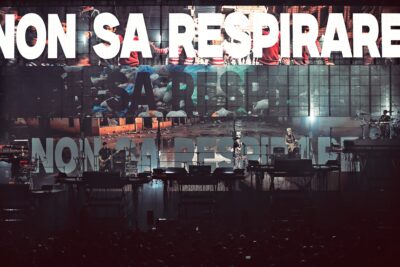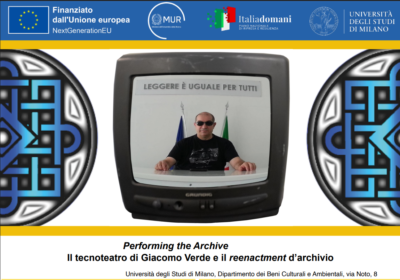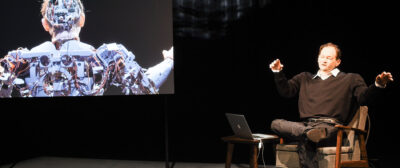BODIES ON STAGE: ACTING CONFRONTED BY TECHNOLOGIES
(CORPS EN SCÈNE: L’ACTEUR FACE AUX ÉCRANS)
March Issue :
Man-Machine Dialogue
Josette Féral
Edmond Couchot,
Philip Auslander
Kris Verdonck
Vincenzo Sansone,
May Issue :
Theatricality and Performativity
Dorota Sajewska and Dorota Sosnowska,
SebastianSamur and Richard Windeyer
Johan Callens
Tony McCaffrey,
July Issue :
Audience Reception
Himalay K. Gohel
AvraSidiropoulou
André Carreira
ProshotKalami
September Issue :
Interdisciplinarity
NeleWynants
Anna Maria Monteverdi,
Christiane Jatahy
Christophe Collard
Bonnie Marranca
NovemberIssue :
Actor Training and CreationProcess in the Digital Era
Andy Lavender
Maria Kapsali,
Hilary Halba and Stuart Young
GwenythDobie, William J. Mackwood, Don Sinclair
Kurt Vanhoutte
Qua alcuni estratti dagli articoli on line nel numero di marzo
Automatism, Autonomy and Aesthetics in Performing Arts
Edmont Couchot
(Translated by Roxanne Lapidus) Les technologies actuellement à la disposition des artistes sont d’une variété et d’une complexité sans précédent par rapport aux techniques classiques. Elles ont permis, notamment aux créateurs de la scène et des arts vivants, de se familiariser avec les robots, les avatars, les acteurs virtuels, et quelques « agents intelligents » invisibles qui hantent les dispositifs et les réseaux de communication. Si diverses qu’elles soient, toutes ces technologies ont en commun, mais à des degrés divers, d’utiliser des modèles informatiques qui s’inspirent de la vie et de l’intelligence.
Le développement des sciences cognitives et de l’informatique a ainsi rendu possible la création d’artefacts capables de simuler des compétences cognitives (perception, attention, décision, invention, jusqu’à la simulation des émotions), des comportements tendant vers l’autonomie, des interactions avec le milieu, propres à l’espèce humaine. Tout se passe comme si, par une inflexion inattendue de l’évolution, en externalisant nos compétences cognitives dans ces artefacts nous donnions vie, à notre insu, à une nouvelle espèce.
Dans cette perspective, dès lors que les artistes — et plus particulièrement ceux de la scène et des arts vivants — utilisent de telles technologies, le propos est de tenter de comprendre ce qui change ou ce qui perdure, dans la création artistique, dans l’effet de présence provoqué par ces artefacts, dans l’expérience esthétique et son partage intersubjectif, voire au-delà, à travers la fréquentation de ces nouveaux êtres, dans la conception même de l’humanisme. [suite…]
Between Body and Object
Kris Verdonck
In this text, Belgian visual artist and theatre maker Kris Verdonck presents the central question running throughout the whole of his oeuvre, namely that of the tension and suspension of the categories of the human subject and the nonhuman object. Discussing a variety of his performative installations, choreography, performances and theatre works, Verdonck shows how objects gain performative, ‘human’, agency, whereas human performers are rendered ‘objective’, all in a critique on the impact of technology on our society, our psyche, our bodies and, the arts. In a second part, Verdonck goes deeper into the methodology and creative process of his work and how ‘listening to the machine’ implies adapting oneself to the object. The importance of text-based dramaturgy, the notion of the figure (Agamben) and the end of humanity and the human world are presented as key elements in an oeuvre creating and reflecting upon going beyond the subject/object divide. [suite…]
Film Acting and Performance Capture :
Philip Auslander
The text touches on uses of digital technology in theater, popular and experimental music, and film acting. Part of what I was interested in was the impact of using such technologies on performers’ technique and also the discursive tendency to describe new ways of doing things in ways that make them sound absolutely continuous with traditional ways and thus belie both the new possibilities and problems of digitally-enhanced performance. [suite…]
The relationship between body and screen
in Studio Azzurro’s performances
since the 1980s until today
Vincenzo Sansone
Studio Azzurro is an Italian group that has been working with different performative languages since the 1980s: video installations, theatre, video art, cinema, interactive installations, interactive museums. In all these artistic experiences Studio Azzurro has never worked using the languages handed down by tradition, but has always experimented by mixing them with new technologies. The work they have conducted in theatre is particular, because the use of new technologies has transformed the concept of theatre and has opened the way for the development of new performative forms such as digital or technological theatre. In this paper we are going to study the relationship between body and screen in Studio Azzurro’s performances. Analyzing some performances achieved between the 1980s and today, we are going to observe how the body moves and acts on the stage when it is confronted with the screen and how in turn the screen reacts to the living presence of the body. The performances we have chosen to conduct our analysis are: Prologo a diario segreto contraffatto (1985), La camera astratta (1987), Delfi (1990), The Cenci (1997), Galileo (Studi per l’inferno) (2006) and Il colore dei gesti (2013). [suite…]
Esprit des lieux, anthropocène et préemption :En attendant Bárðarbunga de François Quévillon

Louise Boisclair
Après l’exposition de l’anthropocène et du mode préemptif, cet article théorique interroge le sens et l’esprit des lieux en miroir avec l’œuvre exemplaire En attendant Bárðarbunga de l’artiste québécois François Quévillon. L’exploration de cette installation, qui expose la surveillance d’indices d’un volcan islandais, introduit une quête paradoxale de la beauté au sublime qui résiste à l’apocalyptique. [suite…]









